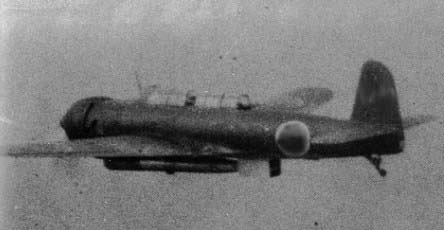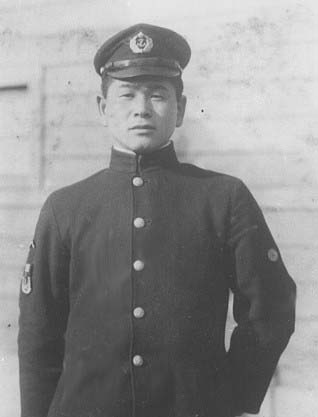The headquarters of the 5th Air Force was at Kanoya Air Base, located in the middle of the Osumi Peninsula of Kagoshima Prefecture. Kushira Air Base, which faces Shibushi Bay, was to the east. This base was used as a sortie base for carrier attack bombers during the Battle of Okinawa. Many bombers carrying torpedoes left Kushira Air Base on Special Attack missions. In those days the following locations were designated as sortie bases for land-based bombers: fighters at No. 1 Kokubu Air Base, carrier dive bombers at No. 2 Kokubu Air Base, and Ginga bombers at Miyazaki Air Base and Kanoya Air Base. The carrier attack bombers of flight corps ordered to participate in operations would proceed to Kushira Air Base, and under the command of the 5th Air Force they carried out torpedo and bombing attacks against enemy ships off Okinawa. Type 97 carrier attack bombers stationed at Usa Air Base, Himeji Air Base, Nagoya Air Base, and Hyakurigahara Air Base, when ordered to form Kamikaze Special Attack Units, also departed one after another from Kushira Air Base. Tenzan bomber Kikusui Units, formed from the 131st Air Group and ordered to make Special Attack sorties, also used Kushira as a sortie base and took off to make attacks of no return against the enemy task force around Okinawa. |
|||||||
|
|||||||
|
There were 39 Tenzan carrier attack bombers used in the Okinawan operations as Special Attack planes (28 confirmed dives at enemy ships). This is exceedingly small when compared to the 630 Zero fighters and the 120 Suisei carrier dive bombers. It was hoped that more than "body-crashing attacks" would be achieved by these different planes. They were expected to carry out close-range torpedo attacks at nighttime, dawn, or dusk from which they would return. However, the probability of being able to return safely was extremely small due to heavy attacks by enemy night fighters guided by radar and damage by fierce anti-aircraft fire. Therefore, over 200 planes that would not return were sent for body-crashing attacks. In such circumstances, although there were slight differences in the dates and times, most crew members of the carrier attack bombers who participated in the Okinawan operations were deployed to Kushira Air Base. Each of the Petty Officers 2nd Class of the 254th Attack Flight Corps of the 131st Air Group (Nobuya Hosaka, Toshikazu Uehara, and Mitsuru Fukusako) sortied from this base one after another carrying torpedoes. Also, each Petty Officer 2nd Class in the 256th Attack Flight Corps of the 131st Air Group (Kenya Hiraoka, Naotoshi Ide, Shigeru Ishikawa, Yoshitaka Shimabara, Kazuo Tanaka, and Tomomichi Sakai) proceeded to Kushira Air Base after completing training. They were all classmates who graduated together with this writer from operational flight training for carrier attack bombers at Hyakurigahara Air Base. One day in late April, Petty Officer 2nd Class Hosaka of the 254th Attack Flight Corps received an order for a nighttime torpedo attack. He finished an early dinner and left for the underground hangar. A good old Type 97 carrier attack bomber was parked there. The mark on its tail indicated that it was clearly a plane from Hyakurigahara Air Base. Although it was a plane expected to be worn-out, it was so nicely painted one could have mistaken it for new. Many centuries ago when the Genji and Heike clans fought each other, the Heike veteran army general Saito Betto Sanemori who went to war ready to die followed tradition by dying his hair white when he went to battle. The ground crew had probably worked through the night to dress up the plane. On April 12, Petty Officer 2nd Class Hosaka had just said farewell with great sorrow at the sorties one after another of Lieutenant Nishimori who commanded the group, Lieutenant Junior Grade Nakanishi, Chief Petty Officer Yokoyama who was senior instructor, and instructors Chief Petty Officer Sunohara, Chief Petty Officer Takao, and Chief Petty Officer Masuko. They had boarded Type 97 carrier attack bombers used in flight training. These planes carried bombs of converted torpedoes to be used for Special Attacks. Without a break on April 16, Chief Petty Officer Yoshiike sortied, following after the others. Who would sortie next? The crew members waiting for a mission assignment looked around to see who would not be there next. Chief Petty Officer Kirihata was there. And next to him, classmates Petty Officer 2nd Class Teruo Yanaga from Fukuoka Prefecture and Petty Officer 2nd Class Tatsuru Sugazawa from Chiba Prefecture were waiting. The parent eagles that had as instructors patiently step by step taught the eaglets until about a half year before this at last were facing the time of death. Even though the young eagles that had just left the nest were repeating torpedo attacks with new and powerful Tenzan carrier attack bombers, it was a terrible contradiction that experienced instructors were forced to carry out one-time only body-crashing attacks in old Type 97 carrier attack bombers. While there are many things I would like to ask and to tell about the situation at Hyakurigahara Air Base after that, I soon left that place with a feeling like I was running away. Let me introduce the last letter of Navy Chief Petty Officer Kotaro Kirihata (from Kunimi Town in Kunisaki-gun, Oita Prefecture), member of the Kamikaze Special Attack Forces No. 1 Seiki Corps. Chief Petty Officer Kirihata was responsible for our flight training as the flight instructor at Hyakurigahara Air Base. Also, after we graduated from flight training, he was assigned to a Special Attack Unit. He went to Kushira Air Base, and at 4:00 p.m. on April 28, 1945, he sortied to Okinawa.
|
|||||||
|
|||||||
|
|
|||||||

